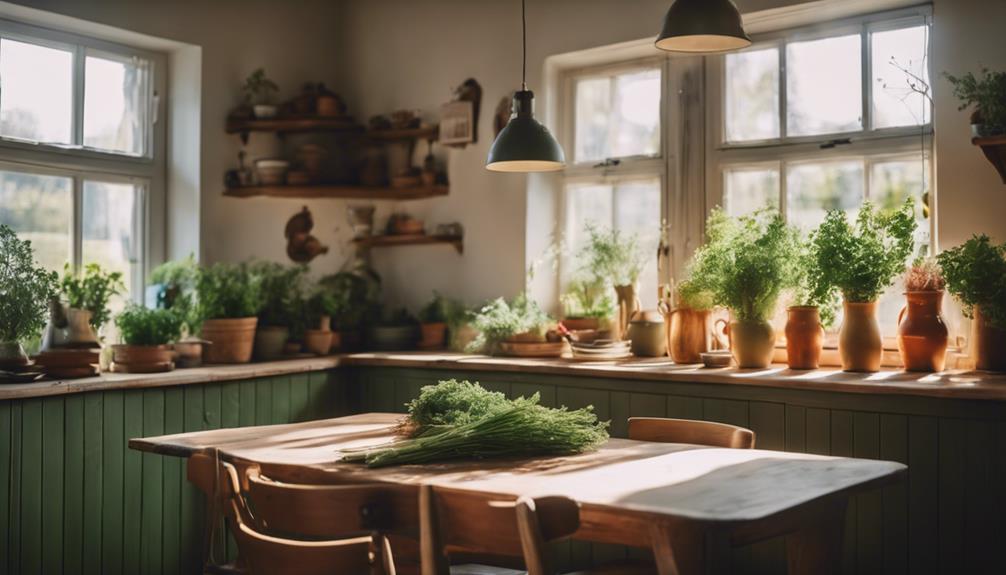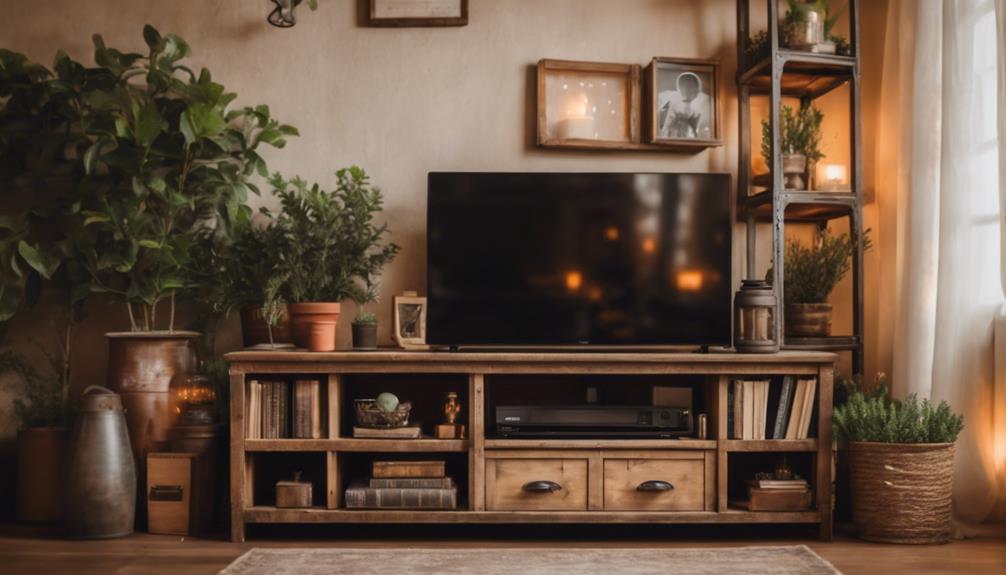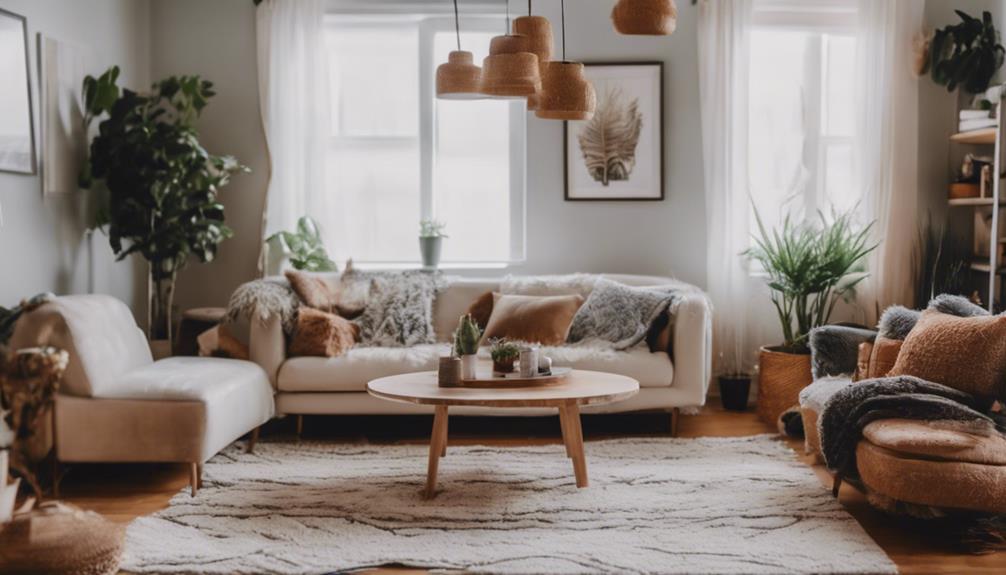Your Scandinavian kitchen can break away from the all-white norm. You have the opportunity to introduce rich hues like deep navy or earthy tones to give it a more dynamic appearance. By incorporating bright accents, such as plaster pink or forest green, you can infuse warmth and personality into the space. Opt for natural materials like light wood cabinetry and durable countertops to create a cozy atmosphere. Don’t forget to add decorative elements like geometric wall art or colorful plant pots for visual interest. Lighting is also essential; consider pendant lights made of natural materials to enhance your kitchen. By embracing these ideas, you’ll craft a kitchen that truly reflects your unique style. Delve deeper into these concepts to find even more inspiration!
Key Elements
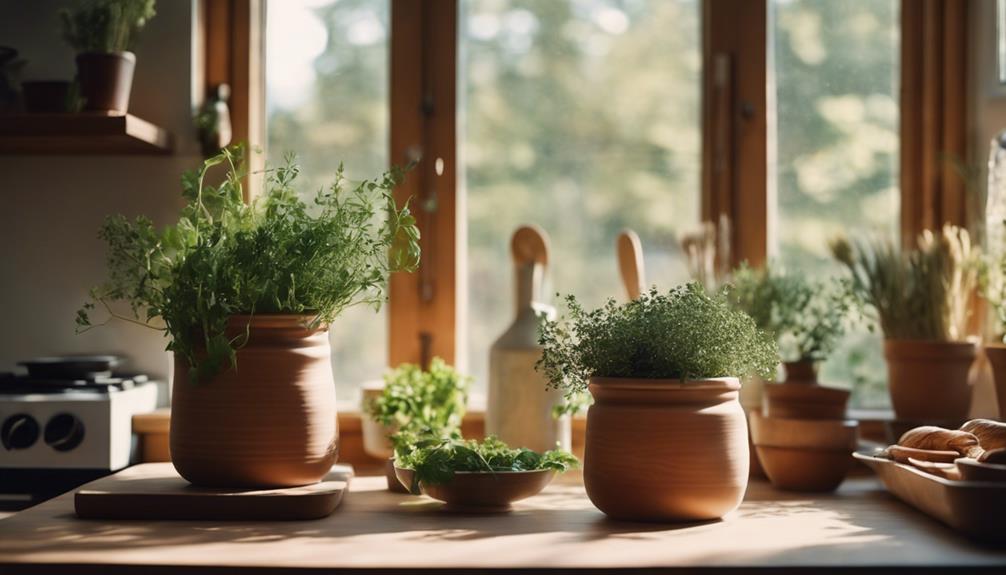
In Scandinavian kitchen design, your choice of color scheme, materials, and textures plays an essential role in achieving the desired aesthetic.
You can create depth with bold hues while incorporating natural materials for warmth and character.
Mixing different textures adds visual interest, making your kitchen feel inviting and stylish.
Color Scheme
Scandinavian kitchen design thrives on a carefully curated color scheme that balances traditional whites with rich hues and soft pastels for a warm, inviting atmosphere. While white remains a staple, don't shy away from integrating deep navy, earthy tones, and pastel shades to create a more dynamic space. A cohesive color palette that combines soft muted tones with natural materials adds visual interest while maintaining that fresh, airy feel.
To enhance warmth and personality, consider incorporating bright accents like plaster pink, forest green, or peppermint green. These pops of color can enliven the space without overwhelming the minimalist aesthetic. Use them sparingly through accessories or statement pieces to reflect your individual style and maintain harmony.
Don't forget to integrate contrasting elements, such as dark cabinetry or colorful furniture, which can provide depth and character. This approach adheres to Scandinavian design principles while allowing your kitchen to feel uniquely yours. By thoughtfully combining these elements, you can craft a Scandinavian kitchen that's both stylish and inviting, proving that it doesn't have to be all white.
Materials
Natural materials often play an essential role in creating a warm and inviting atmosphere in Scandinavian kitchen design. By incorporating elements like wood finishes, you can easily move away from the traditional all-white aesthetic while maintaining a minimalist vibe. Light wood cabinetry, such as birch or pine, works beautifully with neutral tones, ensuring your space feels both cozy and stylish.
For countertops, consider durable options like quartz or butcher block, which introduce subtle variations in color and pattern without overwhelming the design. These materials not only look great but also stand up to everyday use.
When it comes to backsplashes, you can't go wrong with white subway tile or natural stone, both of which offer easy maintenance and enhance the visual interest of your kitchen.
To add personality, think about open shelving made from reclaimed wood or metal. This provides functional storage while displaying decorative items that reflect your style.
Textures
Creating a warm and inviting kitchen involves mixing textures like wood, stone, and textiles to enhance both comfort and style. By incorporating natural elements, you can maintain the minimalist design characteristic of Scandinavian kitchens while adding depth and interest.
Start with wooden finishes, such as butcher block countertops or exposed beams, to introduce warmth and character without overwhelming the space. Pair these with stone surfaces or concrete tiles, which provide a modern yet earthy touch. This combination creates a dynamic contrast that elevates your kitchen's aesthetic.
Don't forget about textiles—linen tablecloths and soft cushions can soften hard surfaces and invite touch. Adding woven baskets for storage not only adds practicality but also brings in more texture, breaking away from a strictly white palette.
Consider mixing matte and glossy finishes, like matte cabinetry alongside shiny metal hardware, to create visual contrast. Layering different materials, such as wood flooring with ceramic dishware, further enriches the environment while ensuring simplicity and functionality.
Embrace these textures to create a Scandinavian kitchen that's not only stylish but also feels like home.
Essential Fixtures and Furniture
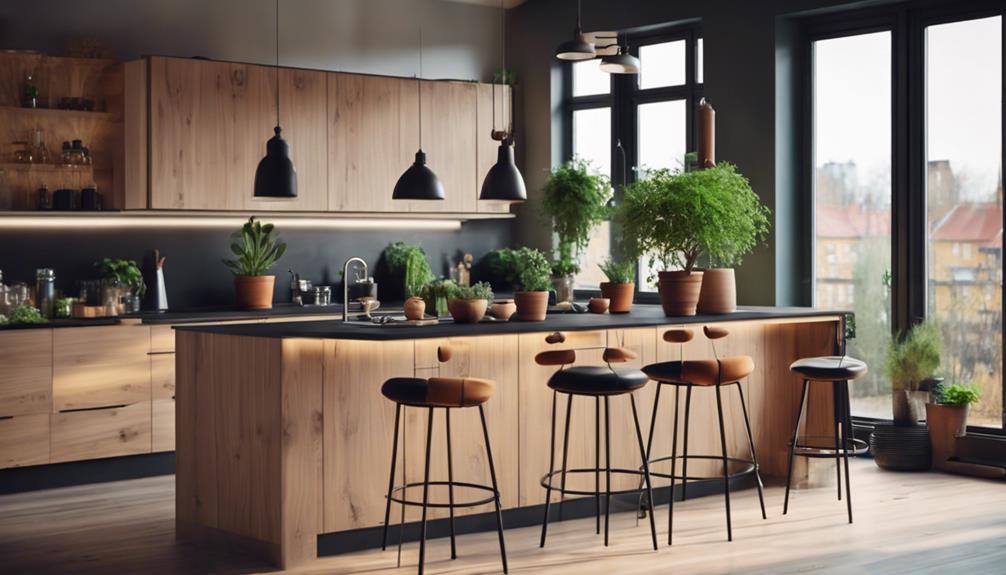
When designing your Scandinavian kitchen, focus on essential fixtures and furniture that enhance both functionality and style.
A Scandinavian-style farmhouse sink, pendant lights, and wall sconces can elevate your space while staying true to minimalist principles.
Each piece contributes to a cohesive look, ensuring your kitchen feels both inviting and practical.
Scandinavian-Style Farmhouse Sink
A Scandinavian-style farmhouse sink combines functionality and aesthetics, serving as a striking centerpiece in your kitchen while simplifying daily tasks. These sinks are often made from durable materials like fireclay or stainless steel, ensuring they stand up to daily use. With their deep basin design, they make handling large pots and pans a breeze, enhancing the practicality of your minimalist kitchen layout.
The beauty of Scandinavian design is its emphasis on clean lines and simplicity, which perfectly complements the straightforward nature of farmhouse sinks. Most options come in classic white or soft muted tones, aligning beautifully with the Scandinavian color palette and promoting a fresh, airy atmosphere in your kitchen.
When selecting your farmhouse sink, consider those with integrated drainboards or accessories. These features not only boost usability but also keep the sleek, uncluttered look that characterizes Scandinavian kitchens.
Scandinavian-Style Pendant Light
Scandinavian-style pendant lights effortlessly enhance your kitchen's aesthetic with their clean lines and minimalist designs. These fixtures embody the essence of Scandinavian style, focusing on practicality and beauty. By choosing pendant lights made from natural materials like wood, glass, or metal, you can create a warm, inviting atmosphere that stays true to Scandinavian principles.
One of the best things about these pendant lights is their versatility. You can opt for statement pieces that serve as focal points, adding a splash of color or unique texture without overwhelming your space. For instance, a bold, colorful pendant can complement a neutral kitchen palette while maintaining the sleek lines characteristic of Scandinavian design.
Adjustable height options allow you to personalize your lighting, making it easy to accommodate various ceiling heights. Consider hanging multiple pendant lights over your island or dining area to foster an intimate ambiance while ensuring ample illumination for cooking and socializing. This approach aligns perfectly with the open, inviting nature of Scandinavian kitchens, making your space feel both functional and stylish.
Scandinavian-Style Wall Sconces
Enhancing your kitchen's lighting design doesn't stop with pendant lights; wall sconces play an essential role in achieving a well-rounded Scandinavian aesthetic. These fixtures often feature minimalist designs with clean lines, perfectly complementing the overall decor of Scandinavian kitchens. When you choose wall sconces, look for options that utilize materials like metal and wood, ensuring a cohesive look throughout your space.
Scandinavian-style wall sconces are designed to maximize natural light, often boasting adjustable arms or shades that direct illumination precisely where you need it. This functionality enhances both the ambiance and practicality of your kitchen. Additionally, many sconces incorporate energy-efficient LED bulbs, aligning with the sustainability principles that are central to Scandinavian design.
You'll find popular designs include sleek geometric shapes and soft, muted colors that blend seamlessly into the neutral palettes common in Scandinavian interiors. Many sconces also emphasize craftsmanship, showcasing artisanal details that add character without overwhelming the minimalist ethos.
Lighting Ideas
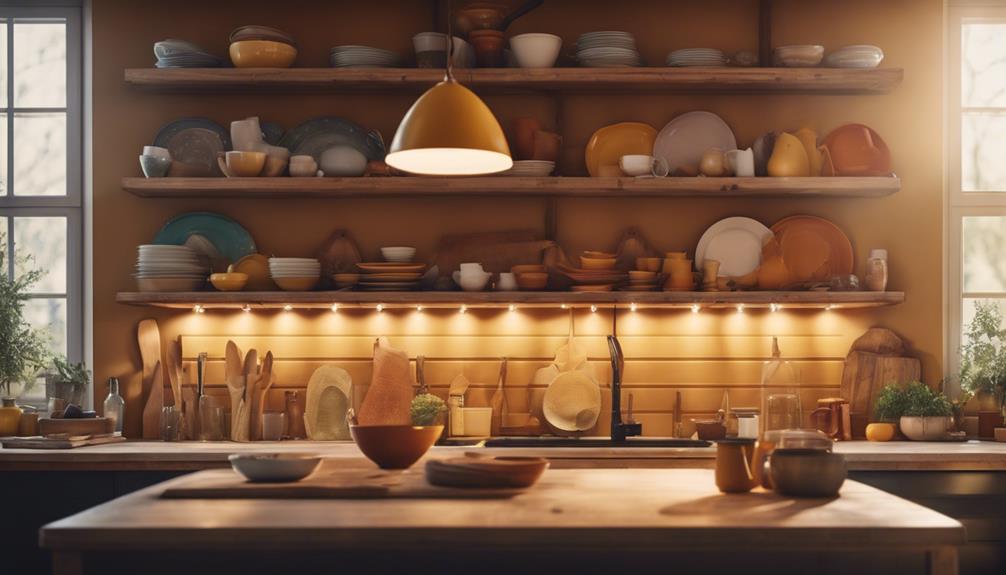
When it comes to lighting in your Scandinavian kitchen, think about how warm LED recessed lights can create a cozy ambiance.
You might also consider Scandinavian-style track lighting to highlight key areas or floor and table lamps that blend functionality with aesthetic appeal.
With these options, you can achieve an inviting atmosphere while keeping the minimalist vibe intact.
Warm LED Recessed Lighting
Warm LED recessed lighting adds a cozy touch to your kitchen, perfectly complementing the minimalist design while ensuring you have the right illumination for cooking and socializing. This type of lighting creates an inviting atmosphere, enhancing the airy feel that's essential in Scandi style interiors.
The warm white light, typically in the range of 2700K to 3000K, beautifully highlights the natural wood tones and soft color palettes commonly found in Scandinavian decor.
You can strategically place recessed lights above essential work areas, such as countertops and islands, providing focused lighting without disrupting the clean lines of your kitchen design. Dimmable warm LED recessed lights are especially beneficial, allowing you to adjust the brightness according to your needs—whether it's a casual family meal or an intimate gathering with friends.
Moreover, incorporating warm LED recessed lighting in open floor plans enhances the overall sense of space and warmth, while minimizing harsh shadows that can detract from your kitchen's aesthetic appeal.
Scandinavian-Style Track Lighting
Scandinavian-style track lighting brings a sleek, minimalist aesthetic to your kitchen while offering flexible illumination options that adapt to your needs. This lighting solution enhances the clean lines typical of a Scandinavian kitchen, providing both functionality and style. With adjustable features, you can direct light exactly where it's needed, whether it's for illuminating work areas or showcasing decorative elements on open shelving.
Incorporating energy-efficient LED bulbs aligns perfectly with the eco-friendly principles of Scandinavian design, helping you reduce energy consumption and maintenance costs. Popular metal finishes like brushed nickel or matte black complement the natural materials and soft color palettes often found in these kitchens, seamlessly blending with your overall decor.
Track lighting also introduces a modern look to traditional Scandinavian spaces, allowing for customizable configurations that reflect your personal style. By choosing this lighting option, you not only enhance the functionality of your kitchen but also elevate its design.
Scandinavian-Style Floor Lamps
Floor lamps embody the essence of Scandinavian design, offering both stylish illumination and functional versatility for your living space. These lamps often showcase clean, minimalist lines and use natural materials like wood and metal, enhancing your decor while providing essential lighting. Popular shapes, such as tripod stands, arc designs, and sleek cylindrical forms, create visual interest without overwhelming the simplicity characteristic of Scandinavian style.
Adjustable features in many Scandinavian floor lamps let you direct light exactly where you need it, ensuring practicality and comfort. This adaptability is key in creating a cozy environment, aligning perfectly with the Scandinavian emphasis on hygge—comfort and coziness.
When it comes to lighting options, warm white LED bulbs are a favorite, as they foster an inviting atmosphere that complements the overall aesthetic. You'll also find that these floor lamps often come in soft, muted colors or natural finishes, allowing them to blend seamlessly with the neutral palettes and natural materials typical of Scandinavian design.
Scandinavian-Style Table Lamps
Incorporating Scandinavian-style table lamps into your kitchen can enhance both the aesthetics and functionality of the space, seamlessly complementing the minimalist lighting solutions provided by floor lamps. These lamps often feature clean lines and minimalist designs, embodying the simplicity that defines a Scandi kitchen. Using materials like wood, metal, and glass, they add a natural feel while maintaining a sleek, modern look.
You'll find that many Scandinavian table lamps come with adjustable features, allowing you to tailor the lighting to different tasks or moods. This versatility is perfect for maneuvering a busy kitchen or creating an inviting dining atmosphere. Opting for soft, warm light bulbs will further enhance the cozy vibe essential for a welcoming environment.
Brands like Muuto and Normann Copenhagen offer stylish and functional options that serve as stunning accent pieces. By choosing the right Scandinavian table lamp, you can easily achieve the Scandi look while ensuring your kitchen is both practical and aesthetically pleasing.
Decorative Elements
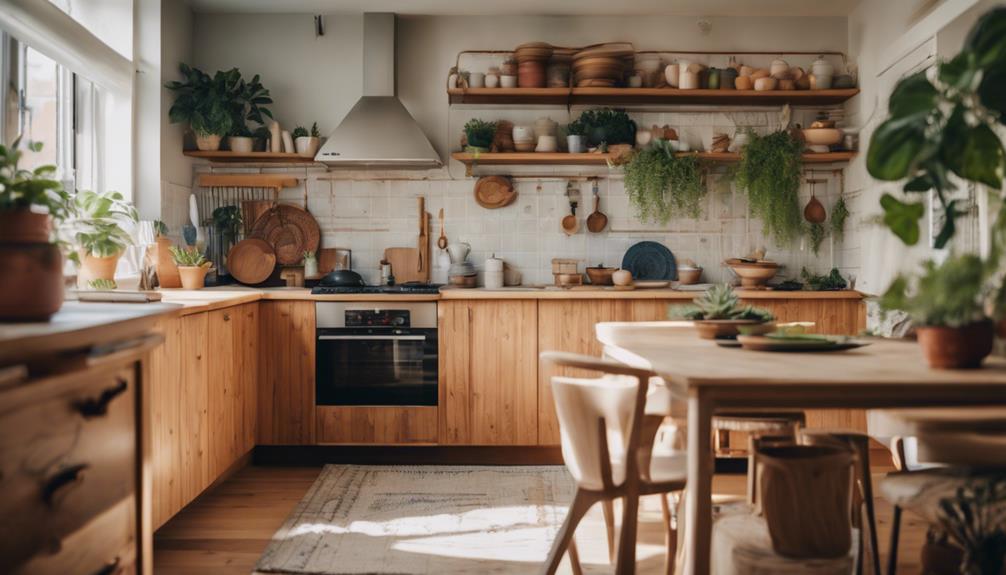
When it comes to adding character to your Scandinavian kitchen, decorative elements like handwoven textile wall hangings, ceramic plant pots, and geometric wall art can make a significant impact.
These pieces not only enhance the minimalist design but also introduce warmth and style.
Let's explore how you can effortlessly incorporate these elements into your space.
Handwoven Textile Wall Hanging
Handwoven textile wall hangings add warmth and texture to your Scandinavian kitchen, creating a cozy atmosphere that breaks up the monotony of neutral tones. These decorative elements, crafted from organic materials like wool, cotton, or jute, align beautifully with the Scandinavian design ethos, emphasizing a natural and harmonious look.
When you incorporate colorful or patterned handwoven textile wall hangings, you not only enhance the visual interest of the space but also express your unique style. This allows your kitchen to deviate from the typical all-white aesthetic, inviting personality into your home.
Additionally, these textiles can serve a practical purpose; they act as sound absorbers, reducing noise levels in open-plan spaces, which can make cooking and dining more serene.
Ceramic Plant Pot
Ceramic plant pots bring a vibrant touch to your Scandinavian kitchen, adding contrast and natural elements that enhance the overall design. With the typical white palette of Scandi interiors, these pots introduce a splash of color and warmth, making your space feel more inviting.
Available in various colors, shapes, and sizes, ceramic plant pots allow you to personalize your decor while adhering to the minimalist aesthetic that defines Scandinavian interior design.
When you incorporate ceramic plant pots filled with greenery or herbs, you not only beautify your kitchen but also improve air quality, creating a more comfortable atmosphere. The matte finishes of these pots complement the clean lines and simplicity of your Scandinavian furniture and accessories, further enhancing the cohesive look of your kitchen.
Whether you opt for a single large pot or a collection of smaller ones, ceramic plant pots can serve as striking focal points. They help you forge a deeper connection to nature, which is at the heart of Scandinavian design philosophy.
Geometric Wall Art
Adding geometric wall art can elevate your Scandinavian kitchen by introducing bold colors and dynamic shapes that contrast beautifully with the typically minimalist decor. This art form breaks the monotony of a white palette, providing visual interest and enhancing the overall aesthetic.
You can choose from various forms, including prints, canvas pieces, or even three-dimensional installations, allowing you to express your creativity and personalize your space. Incorporating geometric shapes not only creates a modern feel but also aligns with the principles of Scandinavian design.
These pieces can serve as focal points, drawing the eye and adding a playful element to your otherwise clean and simple kitchen. Think about how a striking geometric print or a handcrafted sculpture could transform your walls.
Moreover, selecting geometric wall art made from sustainable materials boosts the eco-friendliness that Scandinavian design emphasizes. This choice not only supports a cozy atmosphere but also reflects your commitment to sustainability.
Flooring
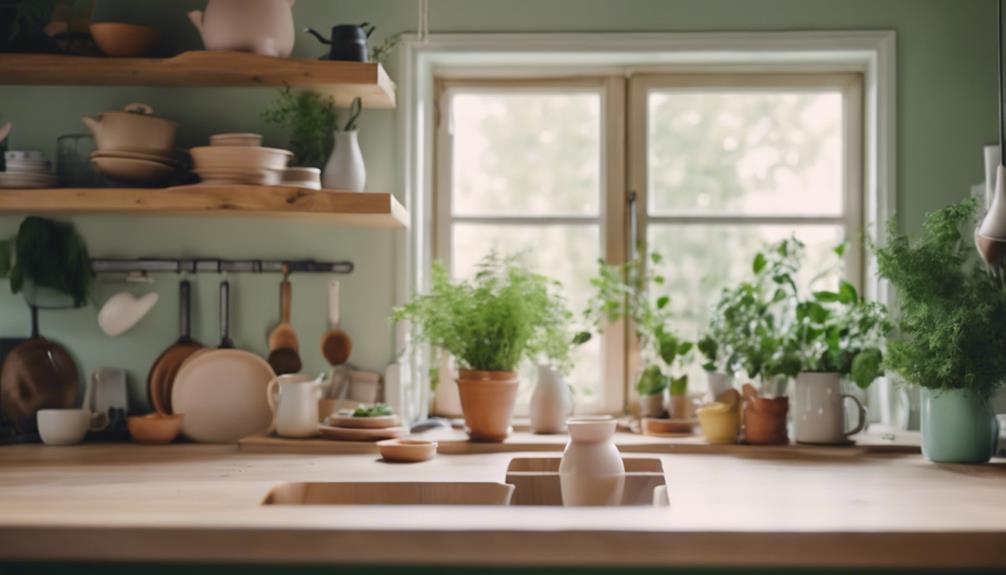
When choosing flooring for your Scandinavian kitchen, light oak hardwood offers a warm and inviting touch that aligns perfectly with the minimalist aesthetic.
If you're looking for something cozier, cork flooring can provide both comfort and insulation.
Alternatively, reclaimed barn wood brings a rustic charm that enhances the overall design while adding character to the space.
Light Oak Hardwood Flooring
Light oak hardwood flooring not only enhances the warmth of Scandinavian kitchens but also complements their clean, minimalist aesthetic. With its warm tones, light oak creates an inviting atmosphere that feels both cozy and stylish. This flooring choice is particularly popular due to its durability and resistance to scratches, making it ideal for the high-traffic kitchen environment.
One of the standout features of light oak is its ability to reflect natural light. By doing so, it enhances the spacious and airy feel that's characteristic of Scandinavian design. The natural grain patterns and textures of light oak add visual interest without overwhelming your kitchen's minimalist aesthetic, ensuring that your space remains serene and uncluttered.
To keep your light oak flooring looking beautiful over time, regular maintenance is essential. Simple cleaning and protective finishes will prolong the life of your floors, allowing you to enjoy their elegance and functionality for years to come.
Cork Flooring for Warmth
Cork flooring offers a sustainable and eco-friendly choice that enhances warmth and comfort in Scandinavian kitchens. Made from the bark of cork oak trees, this flooring option is renewable, regenerating after harvesting. Its excellent thermal insulation helps maintain a cozy atmosphere, especially during colder months, making your kitchen feel inviting.
Beyond warmth, cork flooring also provides practical benefits. Its natural resilience absorbs sound, which can greatly reduce noise levels in busy kitchen areas. This feature contributes to a more peaceful cooking experience, allowing you to focus on meal preparation without distractions.
With a variety of colors and patterns available, cork flooring can complement the light and neutral palettes typical of Scandinavian design. It adds a touch of warmth and texture, breaking up the monotony of an all-white space.
Moreover, cork flooring is hypoallergenic and resistant to mold and mildew, ensuring a healthy kitchen environment. By choosing cork, you not only prioritize style and comfort but also embrace an eco-friendly solution that aligns with sustainable living values.
Reclaimed Barn Wood Flooring
Adding reclaimed barn wood flooring to your Scandinavian kitchen instantly infuses the space with unique character and warmth, blending rustic charm with minimalist elegance. This flooring option not only enhances your kitchen's aesthetic but also offers an environmentally friendly choice, as it repurposes materials that would otherwise be discarded.
Reclaimed barn wood features distinctive markings, colors, and textures, creating a visually appealing contrast against the sleek lines typical of Scandinavian design. Every plank tells a story, adding depth and personality to your cooking space.
Plus, its durability means it can withstand the wear and tear of daily kitchen activities while maintaining a cozy ambiance.
Maintaining reclaimed barn wood flooring is straightforward; regular cleaning and occasional refinishing will keep it looking beautiful for years to come. This practicality doesn't detract from its charm—rather, it enhances the inviting atmosphere that Scandinavian kitchens are known for.
How Can I Incorporate Color into My Scandinavian Kitchen Design Without Losing Its Aesthetic?
When it comes to incorporating color into your Scandinavian kitchen design without losing its aesthetic, consider the principles of color psychology in scandinavian design. You can add subtle pops of color through accessories like rugs, linens, and artwork. Opt for muted, earthy tones to maintain the minimalist and inviting feel of Scandinavian design.
Conclusion
Your Scandinavian kitchen can be a vibrant reflection of your style, not just a sea of white. By incorporating key elements like colorful fixtures and unique furniture, you can create an inviting space.
Don't forget to play with lighting and add decorative touches that speak to you. With the right flooring, your kitchen can truly come alive.
Embrace the versatility of Scandinavian design, and let your personality shine through in every corner!
